CBSE Class 12 Physics Chapter 5 Magnetism and Matter notes in PDF are available for free download in myCBSEguide mobile app. The best app for CBSE students now provides Magnetism and Matter class 12 Notes latest chapter wise notes for quick preparation of CBSE board exams and school-based annual examinations. Class 12 Physics notes on chapter 5 Magnetism and Matter are also available for download in CBSE Guide website.
Magnetism and Matter class 12 Notes Physics
Download CBSE class 12th revision notes for chapter 5 Magnetism and Matter in PDF format for free. Download revision notes for Magnetism and Matter class 12 Notes and score high in exams. These are the Magnetism and Matter class 12 Notes prepared by team of expert teachers. The revision notes help you revise the whole chapter 4 in minutes. Revision notes in exam days is one of the best tips recommended by teachers during exam days.
Download Revision Notes as PDF
CBSE Class 12 Physics Revision Notes Chapter 5 Magnetism and Matter
Properties of magnets:-
- Attractive property
- Directive property:- Magnetic materials tend to point in the north-south direction.
- Like magnetic poles repel and unlike ones attract.
- Magnetic poles cannot be isolated i.e. always exists in pairs.
- Magnetic induction:- A magnet induces magnetism in a magnetic substance placed near it. This phenomenon is called magnetic induction.
- Magnetic field lines:- It is defined as the curve the tangent to which at any point gives the direction of the magnetic field at that point.
- Magnetic dipole:- An arrangement of two equal and opposite magnetic poles separated by a small distance is called a magnetic dipole.
- Magnetic dipole moment:- It is defined as the product of its pole strength and magnetic length.
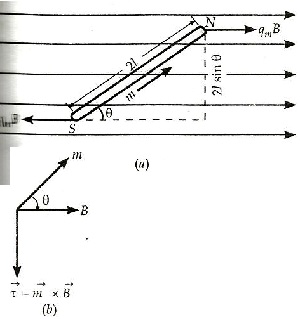
a) The force on it is zero.
b) The torque on it is
c) Torque on dipole will be minimum when = 0o
d) Torque on dipole will be maximum when = 90o.
When a bar magnet of dipole moment is placed in a uniform magnetic field , then-
e) Its potential energy is
where we choose the zero of energy at the orientation when is perpendicular to .- Consider a bar magnet of size and magnetic moment , at a distance r from its mid – point, where r >>l, the magnetic field due to this bar is-
- On the axial point of the dipole (end-on position):-

- On the equatorial point of the dipole (broadside-on position):-

- Current loop as a magnetic dipole:- , where I = current flowing in the loop and A = area of the loop
- Gauss’s Law for Magnetism: It states that the net magnet flux through any closed surface is zero.
- Analogy between electric and magnetic dipoles:-
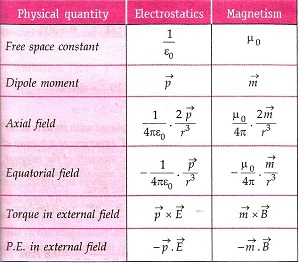
- Earth’s magnetic field:-
| Physical Quantity | Electrostatic | Magnetism |
| Free Space Constant | ||
| Dipole Moment | ||
| Axial Field | ||
| Equatoral Field | ||
| Torque in External Field | ||
| P.E. In External Field |
- Poles:
a) The pole near the geographic north pole of the earth is called the magnetic south pole.
b) The pole near the geographic south – pole is called the magnetic north pole.
c) The magnitude of the magnetic field on the earth’s surface = 4 x 10-5 T.
- Elements of the Earth’s Magnetic Field: Three quantities are needed to specify the magnetic field of the earth on its surface-
a) The horizontal component of earth’s magnetic field (BH)- It is the component of the earth’s total magnetic field in the horizontal direction in the magnetic meridian.
b) The magnetic declination ()- The angle between the geographic meridian and the magnetic meridian at a place is called the magnetic declination at that place.
c) The angle of dip or magnetic inclination ()- The angle made by the earth’s total magnetic field with the horizontal direction in the magnetic meridian is called angle of dip at any place.
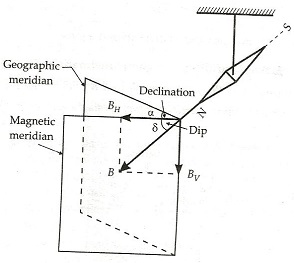
These are known as the elements of the earth’s magnetic field.
- Neutral point:- It is the point where the magnetic field due to a magnet is equal and opposite to the horizontal component of earth’s magnetic field. The resultant magnetic field at the neutral point is zero.
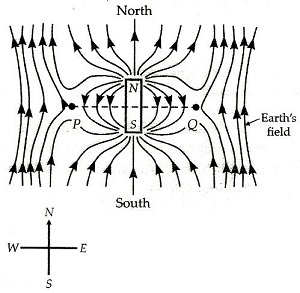
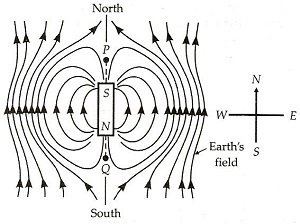
- Magnetic Intensity or Magnetising field intensity:- The ability of magnetising field to magnetise a material medium. Let a material placed in an external magnetic field , The magnetic intensity is,
- Magnetic induction:- It is defined as the total number of magnetic lines of force crossing per unit area normally through a material.
- Intensity of magnetization :- It is defined as the dipole moment per unit volume , then the magnetic field in the material will be-
- Magnetic permeability () :- It is defined as the ratio of its magnetic induction B to the magnetic intensity H.
- Relative permeability () :- It is defined as the ratio of the permeability of the medium to the permeability of free space.
- Magnetic susceptibility () :- It is defined as the ratio of the intensity of magnetisation M to the magnetising field intensity H.
- Relationship between :- ,
- Classification of Magnetic Materials: Magnetic materials are broadly classified as-
a) Diamagnetic- Those substances which develope feeble magnetisation in the opposite direction of the magnetising field. Examples- Bismuth, Copper, Lead, Zinc etc.
b) Paramagnetic- Those substances which develope feeble magnetisation in the direction of the magnetising field. Examples- Aluminium, Chromium, Platinum etc.
c) Ferromagnetic- Those substances which develope strong magnetisation in the direction of the magnetising field. Examples- Iron, Nickle, Cobalt etc.
- Magnetic Susceptibility of the Material for Magnetic Materials:
a) For diamagnetic materials is negative and small.
b) For paramagnetic materials is positive and small.
c) For ferromagnetic materials lies between and
| Property | Diamagnet substances | Paramagnetic substances | Ferromagnetic substances | |
| 1. | Effect of magnets | They are feebly repelled by magnets. | They are feebly attracted by magnets. | They are feebly strongly by magnets. |
| 2. | In external magnetic field | Acquire feeble magnetisation in the opposite direction of the magnetising field. | Acquire feeble magnetisation in the direction of the magnetising field. | Acquire Strong magnetisation in the direction of the magnetising field. |
| 3. | In a non-uniform magnetic field | Tend to move slowly from stronger to weaker parts of the field. | Tend to move slowly from weaker to stronger parts of the field | Tend to move quickly from weaker to stronger parts of the field |
| 4. | In a uniform magnetic field | A freely suspended diamagnetic rod aligns itself perpendicular to the field. | A freely suspended paramagnetic rod aligns itself parallel to the field. | A freely suspended ferromagnetic rod aligns itself parallel to the field. |
| 5. | Susceptibility value () | Susceptibility is small and | Susceptibility is small and positive., where is a small number. | Susceptibility is very large and positive. |
| 6. | Relative permeability value () | Slightly less than 1 |
Slightly greater than 1 |
Of the order of |
| 7. | Permeability value | |||
| 8. | Effect of temperature | Susceptibility is independent of temperature. | Susceptibility varies inversely as temperature: |
Susceptibility decreases with temperature in a complex manner. |
| 9. | Removal of magnetizing field | Magnetisation lasts as long as the magnetizing field is applied. | As soon as the magnetizing field is removed magnetisation is lost. | Magnetisation is retained even after the magnetizing field removed. |
| 10. | Variation of M with H | M changes linearly with H. | M changes linearly with H and attains saturation at low temperature and in very strong fields. | M changes with H non-linearly and ultimately attains saturation. |
| 11. | Hysteresis effect | B-vector shows no hysteresis. | B-vector shows no hysteresis. | B-vector shows hysteresis. |
| 12. | Physical state of the material | Solid, liquid or gas. | Solid, liquid or gas. | Normally solids only. |
| 13. | Examples | Bi, Cu, Pb, Si, N2(at STP), H2O, NaCl | Al, Na, Ca, O2(at STP), CuCl2 | Fe, Ni, Co, Gd, Fe2O3, Alnico. |
- Hysteresis- The phenomenon of the lagging of magnetic induction behiind the magnetising field is called hysteresis.
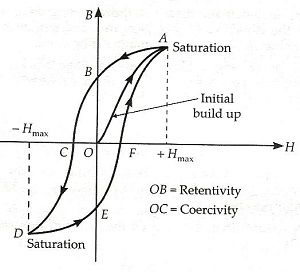
- The magnetic induction left behind in the sample after the magnetising field has been removed is called residual magnetism or retentivity or remanence.
- The value of reverse magnetising field intensity H required for the residual magnetism of a sample to become zero is called coercivity of the sample.
- Permanent Magnets: Substances which retain their ferromagnetic property for a long period of time at room temperature are called permanent magnets. These magnets have High retentivity, High coercivity, High permeability.
- Electromagnets: High permeability, Low retentivity.
CBSE Class-12 Revision Notes and Key Points
Magnetism and Matter class 12 Notes. CBSE quick revision note for class-12 Physics, Chemistry, Maths, Biology and other subject are very helpful to revise the whole syllabus during exam days. The revision notes covers all important formulas and concepts given in the chapter. Even if you wish to have an overview of a chapter, quick revision notes are here to do if for you. These notes will certainly save your time during stressful exam days.
- Physics
- Chemistry
- Mathematics
- Biology
- Accountancy
- Economics
- Business Studies
- Computer Science
- Informatics Practices
- English Core
- History
- Physical Education
To download Magnetism and Matter class 12 Notes, sample paper for class 12 Physics, Chemistry, Biology, History, Political Science, Economics, Geography, Computer Science, Home Science, Accountancy, Business Studies and Home Science; do check myCBSEguide app or website. myCBSEguide provides sample papers with solution, test papers for chapter-wise practice, NCERT solutions, NCERT Exemplar solutions, quick revision notes for ready reference, CBSE guess papers and CBSE important question papers. Sample Paper all are made available through the best app for CBSE students and myCBSEguide website.
- Electric Charges and Fields class 12 Notes Physics
- Electrostatic Potential and Capacitance class 12 Notes Physics
- Current Electricity class 12 Notes Physics
- Moving Charges and Magnetism class 12 Notes Physics
- Magnetism and Matter class 12 Notes Physics
- Electromagnetic Induction class 12 Notes Physics
- Alternating Current class 12 Notes Physics
- Electromagnetic Waves class 12 Notes Physics
- Ray Optics and Optical class 12 Notes Physics
- Wave Optics class 12 Notes Physics
- Dual Nature of Radiation and Matter class 12 Notes Physics
- Atoms class 12 Notes Physics
- Nuclei class 12 Notes Physics
- Electronic Devices class 12 Notes Physics
- Communication Systems class 12 Notes Physics

Test Generator
Create question paper PDF and online tests with your own name & logo in minutes.
Create Now
Learn8 App
Practice unlimited questions for Entrance tests & government job exams at ₹99 only
Install Now